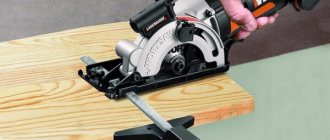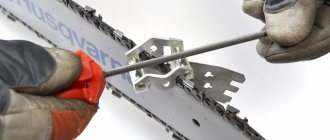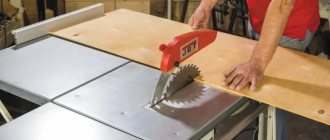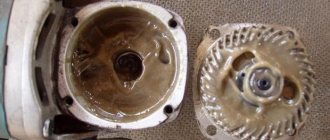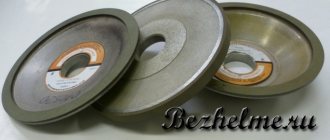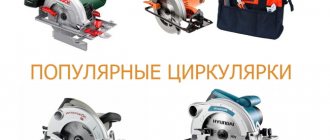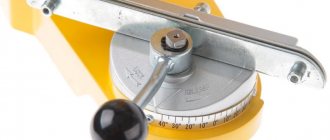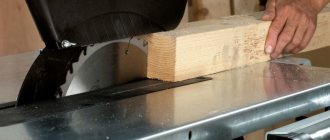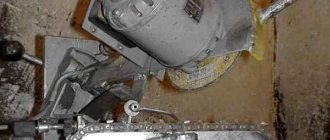Introduction
Professional sharpening of circular saws is carried out on a specialized machine, according to a given program.
The entire technological process can be either automatic or semi-automatic from the beginning of sharpening to the end. The operator only prepares the workplace, places the discs in the washing machine and secures them on the machine bed. The robot manipulator performs the rest of the operations itself. Very convenient and efficient. After such repairs, the blade looks like new and continues to serve perfectly without losing its performance qualities during the sawing process. The question will follow - where to sharpen a circular saw with Pobedit tips, what workshops operate in the region? I do not provide any advertising, all information is provided solely for informational purposes and to help you. Please ask all questions via contact information or in private messages on the blog.
This is what a specialized workshop with equipment looks like.
Before the operator starts work, he must make a preliminary diagnosis of your disks, as well as check the wear and runout of the disk. Only after these measures have been carried out, a program for sharpening a circular saw with pobedit tips, if any, is selected.
Types of saws
If the disk is properly sharpened and the teeth are set according to the pattern, then it can process the workpiece in any direction relative to the wood fibers.
There are these types of tools:
- saw with carbide blades;
- discs made of solid metal;
- discs with teeth treated with hard material;
- discs with heavy-duty soldered teeth.
Hardwoods are processed with discs that have special grooves. Technological breaks prevent tool deformation and prevent it from overheating during the production cycle. Vibration and background noise are also significantly reduced, and the quality of the line formed by the cut is improved. The saw has teeth that are machined at a certain angle, each tooth has several cutting edges.
There is a main edge, additional ones are mated to it, and intersecting planes are formed:
- A;
- IN;
- WITH.
The planes themselves also vary in different mates.
The teeth can be straight, they are usually used for preliminary cutting of material. These teeth provide a low level cut. However, the productivity of such teeth is quite high.
Beveled teeth provide a more precise line and are suitable for cutting materials such as:
- plywood;
- PVC sheets;
- chipboard;
- Fiberboard.
The teeth ensure an even cut without the material crumbling.
There are also discs in which there is a bevel at the leading edge of the cutter, and there is also a bevel with the trailing edge. Options for alternating different teeth with different bevels are possible. Such tricks ensure a clean cut, but you should remember: the denser the material, the faster such teeth become dull.
Trapezoidal tooth – this tooth configuration ensures long tool life. Often a complex design is used, when trapezoidal and straight teeth alternate. The latter make the primary cut, which allows straight-shaped teeth to “polish” the cut.
Cone-shaped tooth - these teeth are auxiliary and are designed to work with materials that have a laminated surface. They ensure correct cutting without the formation of any chips.
Sickle-shaped tooth - in this case, the teeth are bent, which makes it possible to accurately cut the material across the wood fibers.
Types of teeth
The teeth are divided depending on the shape of the cutting edge and the direction of its slope. For soft wood, a straight tooth will work. It cuts with the main edge positioned perpendicular to the cutting line. When creating a groove in a part, a recess with a flat bottom is obtained.
The inclined blade gradually cuts into the wood, increasing the load. The working edge can be tilted to the right and left. Discs with alternately beveled teeth have the greatest productivity.
For dense rocks, trapezoidal sharpening is used, when the 3 main cutting edges form a trapezoid.
Each type of tooth has its own designation. The table contains the main types of sharpening of cutting blades on circular saws.
| Symbol | Tooth type name | Number of cutting edges | Cutting edge shape |
| G.M. | With straight tooth | 1 | Straight, perpendicular to the axis |
| GK | Alternately beveled | 1 | Inclined at an angle of 40⁰ |
| G.S. | Alternately beveled | 1 | Inclined at an angle of 10⁰ |
| GA | With trapezoidal and straight | 1 and 3 | Alternating straight and beveled teeth |
| GT | Trapezoidal | 3 | Trapezoid |
| GR | Conical tooth | 3 | Frustum |
In addition to the main cutting edges, there are auxiliary ones: back and side. They form a cut and remove irregularities left behind by the blade.
Required Tools
You can sharpen disks for a circular plate with your own hands only if you have special tools. There is also a machine that allows you to automate the process and make it more efficient.
To carry out the work of sharpening a disc with your own hands, you can use the following tools:
- assembly vice;
- file;
- block of wood.
You can also use a circular saw sharpener, which does not require the above tools.
When is it necessary to carry out restoration work on circular saws?
A rather important issue is determining when circular saws should be sharpened. Excessive wear may make it impossible to carry out such work. There are three clear signals that determine the need to sharpen a circular saw blade:
- Smoke appears, the protective casing heats up. The device, as a rule, has a special protective casing, which can heat up if the disk becomes dull. It should also be noted that in special cases, smoke appears due to the strong heating of the cutting zone.
- Also, with mechanical feeding, when the pressure is adjusted with your own hands, great force should be applied to obtain the desired result.
- When processing wood or other material, traces of soot and a corresponding odor appear in the cutting area.
In the above situations, it is recommended to sharpen the circular saw blade.
Home processing of toothed blades
To process a circular saw, it is not at all necessary to have a special machine for sharpening circular saws with your own hands. To secure the canvas in a certain position, you can use a flat stand, which has several nuances:
- The surface should be flush with the center of the sharpening wheel.
- The sharpening plane should be at an angle of 90 degrees relative to the gear wheel.
- To create different inclinations, the device must have a swivel joint.
To select the desired angle, make a mark with a colored marker. The device must be installed in a powerful vice. Even the slightest movement of the special stand is not allowed.
Originally posted 2018-03-28 15:29:34.
Do-it-yourself saw sharpening at home
Figure 4. In order for sharpening to be correct and fast, the disc should be well secured.
You can sharpen your saw at home. To do this, it is not necessary to have a specialized sharpening machine in your own workshop, which costs a lot of money and is rarely used for its intended purpose.
But simply holding the disc in your hands and sharpening the teeth on a grinding wheel while suspended is irrational. No amount of steady hand or excellent eye is enough to make the cutting element impeccably sharp and suitable for effective work. For this purpose, care should be taken to make the simplest fixing device (Fig. 4).
Its surface should coincide with the level of the grinding disc axis. The gear wheel itself is placed on the stand so that the planes of the teeth to be sharpened are perpendicular to the saw blade. To sharpen beveled teeth along the front and rear surfaces, this device is made with a movable hinge.
However, in this case it is difficult to maintain the same value of the front and rear sharpening angles. To eliminate this problem, the center of the saw wheel is rigidly fixed in the desired position in relation to the abrasive disc. This is done either using a groove for a mandrel, which is mounted on a stand to place the saw being sharpened on it, or by installing special stops on the stand that secure the saw blade at the required angle to the sharpening wheel.
If you meet all the requirements for the technology of sharpening carbide circular saws, then they will serve a person for a long time and effectively.
Sharpening circular saws is a mandatory activity during the operation of this equipment. Wood processing requires the master to have tools with appropriate cutting properties at his disposal. Just like sharpening chainsaws, circular saws require extra attention. If the shortcomings are not corrected in time, over time the tool will begin to become dull much faster.
If there is no machine for sharpening saw blades
Precisely maintain the required sharpening angles while holding the weight of the saw in your hands.
The task is impossible even for a person with a unique eye and enviable stiffness of hands. The most reasonable thing in this case. to create a simple sharpening device that allows you to fix the saw in a certain position relative to the circle. The simplest of these tools is a grinding stand, the surface of which is at the same level as the axis of the grinding wheel. By placing the saw blade on it, you can ensure that the front and back planes of the tooth are perpendicular to the saw blade. And if the upper surface of the stand is made mobile. fixing one side hinged and the other. Relying on a couple of bolts that can be screwed in and out. then it can be installed at any angle, making it possible to sharpen an inclined tooth on the front and rear planes.
True, in this case one of the main problems remains unresolved. Extracting the same front and back corners. This problem can be solved by fixing the center of the saw in relation to the abrasive wheel in the desired position. One way to implement this. Make a groove on the surface of the mandrel support on which the saw is mounted. By moving the frame with the wheel in the groove, it will be possible to maintain the required tooth cutting angle. But to sharpen circular saws of different diameters or sharpening angles, it must be possible to either move the motor or the support, and with it the groove. Another way to ensure the desired sharpening angle is simpler and install stops on the step that fix the disc in the desired position. At the end of the article there is a video demonstrating this adaptation.
How to sharpen: basic methods
There are two available methods for sharpening circular saws - manually and using a machine. In order to sharpen a disc correctly at home, you need to take into account some nuances.
Manual method
Special machines for sharpening saw edges are rarely used in domestic conditions because their cost is high. Therefore, in the absence of such a device, you can cope with sharpening with improvised devices, for example a grinder. In this case, it is forbidden to hold the circle in your hands without fixing it with anything. Otherwise, it will not be possible to achieve a sufficient cutting angle for further work with the material.
To securely fix the circle in the correct position, use a flat stand.
Some features:
- the surface of the stand coincides with the level of the grinding disc axis;
- a gear wheel is placed on it so that the sharpening plane becomes perpendicular to the saw blade;
- The design of the device is complemented by a rotary hinge.
The stand will help you comfortably position the saw blade for processing relative to abrasive material. Before starting work, clear markings are carried out. A colored marker is used for this. They draw lines that will allow you to sharpen the element at the desired angle. A vice will help securely secure the disc to the surface.
Video of sharpening a circular saw blade with a grinder:
Using the machine
When the craftsman has access to a special sharpening machine, the processing of elements occurs quickly and efficiently. This device is small in size, so working with it is comfortable even for a beginner. There will be no problems even when used in domestic conditions.
When purchasing such a device, look at the abrasive wheel. To select it, certain nuances are taken into account:
- It is best to purchase a circle made of diamond-coated CBN or green silicon carbide;
- If a carbide blade is sharpened, problems may occur even when using a machine.
The process of using the sharpening machine is extremely simple. The operator must place the disk comfortably on the device and clamp it using a special clamp. Before starting work, it is recommended to mark the first tooth with a marker. This will help you avoid getting confused while sharpening and not checking teeth that have already been processed. To select the sharpening angle, a special meter is provided on the device. You should set the required angle on it, after which the device will perform the task independently.
A circular saw is a useful tool that you cannot do without during construction. It helps to make cuts in surfaces, as well as change their shape and size. To sharpen discs, special machines or improvised materials are used. Doing the work with your own hands is not so difficult, you need to follow the recommendations listed and not be afraid.
Sharpening a disk with pobedite tips:
Manufacturing
Step-by-step instructions for making a homemade machine for sharpening circular saws:
- Manufacturing a frame from a metal sheet, corners. It must be sustainable.
- Install the engine and secure it to the base.
- Install the caliper. It is advisable to order a finished part from professionals.
- Install a mechanism for setting different angles of the abrasive wheel.
- Make protective shields from metal or plastic sheets. Attach to the machine.
- Connect the wires to the start buttons, bring out the cable to connect to the network.
After carrying out the manipulations, all that remains is to check the reliability of fastening of the parts and perform a starting start. After the first sharpening on a homemade installation, you need to calibrate the position of the abrasive wheel to set the required angle.
Any equipment becomes dull over time. The teeth of a circular saw without sharpening will not only spoil the material being cut, but can also be destroyed during the work process. To avoid problems, it is necessary to sharpen the cutting parts in a timely manner. For this, special equipment is used that you can assemble yourself.
Determining the degree of wear and sharpening angle
Circular saws, sooner or later, lose their performance characteristics during operation; it is possible to effectively extend the service life of the tool if it is sharpened again correctly. This operation is simple; in many cases you can do the work yourself.
First of all, you should have an idea: what parameters does the working disk of the unit have?
The second most important parameter is the sharpening angle, what parameters the tooth itself has
Before you start working, you should test the tool to understand how relevant its restoration is. The disc should be inspected by removing it from the machine. An important indicator is the change in size, this can be seen even with a cursory examination.
The “knobs” themselves are made of heavy-duty steel of the following grade:
- 9HF;
- 50 HVA;
- 65G.
Some other grades of steel are also used.
This material stands out for its strength and wear resistance, but it also requires preventive treatment.
The teeth themselves have a standard prescribed in GOST 9768-78, however, each manufacturer has differentiation in inclination angles and shapes.
In the absence of a template, you will need to determine the parameters of the teeth yourself. There is a tool for this - a pendulum protractor. With this tool you can accurately set the sharpening angle.
Another option is to take a new disk and use it as a template. You should take a sheet of thick cardboard and draw precise outlines on it with a pencil. Then, using a pendulum angle gauge, the exact configuration of the soldering should be established. It is recommended to save this sample; you can work with it in the future, using it as a standard.
After finishing the work, it will be necessary to test the resulting sample by comparing it with the standard. The angle of inclination in such saws ranges from 15 to 25 degrees.
Something to keep in mind when starting work: the rake angle may have a negative value. Similar models are used for working with PVC sheets, as well as soft metals.
Methods
You can sharpen the instrument yourself (if it does not have a pobedit coating) at home. And also in such cases, you can use a simple machine on which you can successfully sharpen any edges. It is very important to choose the right circle.
They come in the following types:
- corundum;
- diamond
It is best to use a unit in which the disc can be positioned at different angles.
Equipment for sharpening tipped discs is not cheap and can only be found in specialized technical centers.
It is forbidden to move the sharpening yourself:
- it costs extra labor;
- the accuracy of manual movement will be poor;
- If you do not have the skill to sharpen wheels, it is recommended to turn to professionals.
There are rules:
- the main defect occurs on the edge from above, that is, the edges are rounded within 0.11-0.31 mm - this is the starting point from which sharpening should begin;
- Both the front and rear parts should be processed, this should be done at least 26 times;
- size does not exceed 0.051-0.151 mm;
- front and back edges are processed identically;
- After the end of the cycle, the finishing process should be carried out, that is, clean the surface with “zero” sandpaper.
The work of creating a new configuration requires compliance with regulations and has its own complexity.
- Familiarize yourself with the requirements, in particular, clarify the number of revolutions. It is clear that for metal this figure will be noticeably lower. Wooden elements are processed with a large number of revolutions.
- The material from which the soldering is made can withstand heavy loads, its service life is significant, but even it sooner or later receives defects, chips and cracks appear.
- A sure sign that the material is beginning to “tire” is the appearance of microburrs and roughness on the surface. Defects will appear in these places after some time.
To carry out sharpening correctly, you should know what types of teeth there are:
- straight;
- tooth with a bevel on the back;
- trapezoidal;
- cone-shaped;
- concave.
How to sharpen:
- The disc should be thoroughly cleaned using alcohol or chemicals;
- all working planes are processed;
- it is permissible to remove metal 0.051-0.151 millimeters;
- sharpen perhaps no more than twenty-five times;
- you can sharpen using a special file, if you have practical experience;
- It is recommended to sharpen carbide teeth using separate equipment;
- Victory tips can only be “taken” using a special machine that contains a diamond wheel.
Markers should be made to mark the starting point. The teeth are arranged in such a way that they are in a single plane. After completing the sharpening cycle, each tooth is tested and processed separately.
There are several types of tooth alignment.
- Wavy, each tooth is straightened at a certain angle of inclination, thus creating a semblance of a wave.
- Protective, two teeth have angles of inclination, the third tooth is present without inclination. This method is effective even when working with mahogany and oak.
- Classic, when the teeth are variable - angles of inclination to the left and right.
- Frontal.
- Rear.
- A tilt is made at the frontal plane.
- A tilt is made at the rear plane.
There is another parameter - the sharpening angle, but it usually “works” as an additional tool.
For manual sharpening you will need:
- wooden blocks (2 pieces, size 52x32 mm);
- drill, screwdriver;
- screwdriver bit;
- a hacksaw for processing ceramics;
- marker;
- ruler;
- screws or self-tapping screws.
The middle of the bars is cut out, they are fixed on a solid plane using self-tapping screws. A mark is made on the bars so that a crown for processing ceramics is then placed in the sawn markings, which, in turn, is attached to a screwdriver.
The surface of the stand coincides with the surface of the disc. The circle lies on a stand, the sharpening plane should be at an angle of 90 degrees to the saw blade. This simple device is equipped with a swivel unit. Such reliable fastening allows you to evenly process all the teeth of the tool. Using a marker, you make markings, which makes it possible to correctly determine the angle of inclination.
Necessity of the procedure
Circular saws are needed both in private households and in production. When building a house, creating furniture, cutting boards, timber - a similar tool is required everywhere. Properly sharpening a circular saw requires practical skill and knowledge.
Circular saws compare favorably with other cutting tools:
- chain;
- saber;
- longitudinal.
Disc circular devices have significant productivity, and their service life is also much longer. Sharpening circular saws is an important necessary step; without it, the tool will not work fully. Thanks to various attachments with carbide tips, as well as pobedit coatings, cutting can be carried out with both wood and metals.
To sharpen discs with different attachments, special equipment is required. If the disk is treated “scientifically”, this will greatly extend its service life.
Timely sharpening of circular saws is carried out when there are several obvious signs.
- The engine begins to experience unnecessary loads. The reason is simple - the teeth are dull and additional resources are required to process the material. There is a danger: if the disk is damaged, if there is no engine shutdown relay, the machine may fail.
- If chips and chips form on the cut, and the cut itself becomes too wide, then this is a sure sign that the tool should be repaired.
- A foreign smell of burnt material appears, and dark spots are visible on the cut line.
- The time required to process a part increases.
How to sharpen: basic methods
There are two available methods for sharpening circular saws - manually and using a machine. In order to sharpen a disc correctly at home, you need to take into account some nuances.
Manual method
Special machines for sharpening saw edges are rarely used in domestic conditions because their cost is high. Therefore, in the absence of such a device, you can cope with sharpening with improvised devices, for example a grinder. In this case, it is forbidden to hold the circle in your hands without fixing it with anything. Otherwise, it will not be possible to achieve a sufficient cutting angle for further work with the material.
To securely fix the circle in the correct position, use a flat stand.
- the surface of the stand coincides with the level of the grinding disc axis;
- a gear wheel is placed on it so that the sharpening plane becomes perpendicular to the saw blade;
- The design of the device is complemented by a rotary hinge.
The stand will help you comfortably position the saw blade for processing relative to abrasive material. Before starting work, clear markings are carried out. A colored marker is used for this. They draw lines that will allow you to sharpen the element at the desired angle. A vice will help securely secure the disc to the surface.
Video of sharpening a circular saw blade with a grinder:
Using the machine
When the craftsman has access to a special sharpening machine, the processing of elements occurs quickly and efficiently. This device is small in size, so working with it is comfortable even for a beginner. There will be no problems even when used in domestic conditions.
When purchasing such a device, look at the abrasive wheel. To select it, certain nuances are taken into account:
- It is best to purchase a circle made of diamond-coated CBN or green silicon carbide;
- If a carbide blade is sharpened, problems may occur even when using a machine.
The process of using the sharpening machine is extremely simple. The operator must place the disk comfortably on the device and clamp it using a special clamp. Before starting work, it is recommended to mark the first tooth with a marker. This will help you avoid getting confused while sharpening and not checking teeth that have already been processed. To select the sharpening angle, a special meter is provided on the device. You should set the required angle on it, after which the device will perform the task independently.
A circular saw is a useful tool that you cannot do without during construction. It helps to make cuts in surfaces, as well as change their shape and size. To sharpen discs, special machines or improvised materials are used. Doing the work with your own hands is not so difficult, you need to follow the recommendations listed and not be afraid.
Sharpening a disk with pobedite tips:
A disk tool for cutting wood is always useful during construction. A circular saw is convenient because it allows you to quickly cut material with minimal effort and time. As for the quality of the cut, we can say that it is ideal, but only when the saw is in good working order and well sharpened. Otherwise, working with such a tool is even dangerous, so you should sharpen the circular saw.
It is not difficult to determine the need for sharpening: a blunt tool cuts the workpiece poorly, which is immediately noticeable. There are two options here: either take the blade to a workshop, which is not always profitable in terms of time and money, or sharpen the circular saw with your own hands. This may seem difficult at first glance. But if you delve into the essence of the saw in more detail, it will not be difficult to service the tool at home.
Application of the machine
The simplest machine for working at home is a motor with an abrasive. The wheels can be diamond, CBN or silicon carbide.
The tooth to be sharpened is located on the plane so as to be perpendicular to the blade. After turning on the engine, the blade is brought to the circle and pressed against it with a tooth. The layer of metal being removed is regulated by the pressing force. Having finished working with one tooth, the next one is approached using the same method. And so on in a circle until the end.
For the purpose of universalization, the stand is being modernized. The front part is made movable, and a pair of bolts are screwed into the rear. With their help you can adjust the tilt of the canvas. It becomes possible to sharpen the front and back planes of an oblique tooth.
The problem of maintaining the same front and rear sharpening angles remains. To do this, it is necessary to fix the blade relative to the center of the abrasive wheel. To do this, the disk is inserted into a special mandrel, and a groove is made in the stand for it. The required sharpening angle is maintained by moving the mandrel along the groove. If the diameter of the disks is different, then it must be possible to move the engine or stand with a groove.
Another way is to install stops that will fix the desired position of the disk.
Expert advice
Experience is a useful thing, thanks to which you can avoid a number of mistakes typical for beginners
Therefore, paying attention to the advice of experts is very useful if you want to achieve a positive result for yourself when turning a circular saw.
- Always use safety glasses. For some reason, many people ignore this rule, which is why the masters themselves then suffer. Therefore, before you start sharpening, be sure to wear all the necessary protective equipment;
- Do not attempt to remove more metal than required. Remove just enough to remove all existing cracks, burrs and irregularities;
- During turning, be sure to keep the disk in a constant position;
- If the disc has not been sharpened for a long time, you will have to remove a larger layer of metal;
- Keep all teeth identical in shape and height.
Initially, it seems that sharpening is a technologically complex process. But with a little experience, you will be able to sharpen circular saw blades easily.
It is most convenient to sharpen on a special production machine. However, many home craftsmen make their own design for this purpose, which significantly saves time and money.
Saws made from high-quality materials become dull less often, which means they require sharpening infrequently. However, if the discs are made of low-quality material (and this happens quite often, and even an experienced master cannot always determine the quality of the metal “by eye”), most likely they will have to be sharpened often. Therefore, any home craftsman who uses a circular saw should know how to sharpen it.
Marking
As you can see in the picture, the disc markings can tell you about many technical characteristics. But there is a dependence that should not be neglected: the shape of the teeth directly affects the ability to work with a specific material.
The classification developed by representatives of the GASS divides discs into the following categories based on tooth shape :
GK and GS:p alternately beveled . Suitable for processing all types of wood and “clean” chipboards , without plywood and plastic coatings.
GM : direct . They can only cope with cutting soft wood.
GT : trapezoidal . They are useful in cases where you need to cut MDF or chipboard with lamination.
GR : conical . Cuts multi-layer coatings with double lamination.
GA : trapezoidal and straight . Same features as GT .
laser markings to high-quality saw blades . If the parameters are “written” with ordinary paint , it means that we are looking at an economy-class product that will quickly become unusable.
Basic sharpening angles for circular saws
The tooth of a circular saw, which is usually made of carbide metal, has a complex structure. It has three cutting edges as standard, so you need to sharpen the teeth in such a way as to sharpen these edges. But the main thing when sharpening is to observe the angles at which the tooth planes diverge from the edges, and the angles of attack between the tooth plane and the workpiece. The last point is important to maintain the characteristics of the saw blade.
The front edge, the one that first cuts into the workpiece as the saw moves, forms the main cutting edge with the rear edge. The angle at which the rake edge meets the material is called the rake angle Y (angle of attack). The angle between the back edge and the front edge is the sharpening angle. If you subtract the rake angle and the point angle from 90 degrees, you get the back angle.
In practice, it is important to maintain these angles for each type of blade when sharpening. It is according to the front angle that saws are divided into types:
- Longitudinal cutting, where the rake angle should not go beyond 15–25 degrees.
- Transverse cutting, where it is permissible to sharpen the front edge of the tooth at an angle of 5–10 degrees.
- Universal discs that can handle both longitudinal and transverse cuts quite easily; their rake angle should be maintained around 15 degrees.
The bevel angle of the rear and front planes is also important: the sharper it is, the easier it is for the saw to enter the material, but wear occurs faster.
Important Features
So that readers do not get lost in the wilds of the modern market for accessories for circular saws, we have prepared 5 main criteria that will help you make your choice. Let's consider them in order of importance.
External diameter
The outer or outer diameter of the disk should not exceed the dimensions of the circular saw casing, otherwise it will not be possible to install it in the seat. Increasing the parameter leads to an increase in the depth of cut. The characteristics vary from 65 to 500 mm.
Landing diameter
Landing, or internal diameter - the size of the hole in the center of the equipment. Determines whether the saw blade will fit on the spindle. The most popular sizes: 16 , 20 , 22 , 30 and 32 mm. But the full range is much wider - from 11 to 50 mm.
Manufacturers may install pins on the saw seat for additional fixation . In this case, you need to choose a disk with appropriate holes .
Number of teeth
As the number of teeth increases the processing speed decreases , but the cleanliness of the cut improves . And vice versa: the fewer teeth, the faster the work goes , but the cut becomes less and less accurate . The characteristic has its own classification, presented in the table:
| № | Name | Number of teeth, pcs |
| 1 | Big | 80-90 |
| 2 | Average | 40-80 |
| 3 | Small | 10-40 |
Tooth sharpening angle
Sharpening inclination is the angle of deviation of the cutting edge of the tooth from the radius of the saw blade. The picture clearly shows how a characteristic can influence the work process. The angles are:
Standard : 5-15 °. Universal sharpening. Suitable for all types of cuts.
Positive : 15-20 °. Ideal for rip sawing due to its gripping effect.
Negative : from to - 5 °. Used for cross cutting, does not form chips.
Disc thickness
The standard parameter is 3.2 mm. The thinner the disk, the more it heats up and the faster it fails. The large thickness guarantees a long service life of the equipment, but slows down the work. In this case, the excess consumption of material increases due to the wide cut.
Geometry of cutting elements
The working element of the saw - the tooth - has a certain geometric shape with the presence of not one, but several cutting edges. There is always one main edge and additional ones formed by the intersection of planes “A”, “B” and “C” in certain combinations. To work with different materials, it makes sense to select discs with the most suitable shape of cutting teeth.
Straight tooth
A saw blade with such a working zone is intended for rough cutting of lumber. The cut is rough, of low quality, and the operations are carried out relatively quickly.
Beveled tooth
The front plane of the cutting edge, made in this form, ensures cuts with an accurate and even line. The saw is ideal for working with composite type materials: plywood, chipboard (with single-sided and double-sided lamination). After cutting blanks of solid lumber, it is chipped, practically no chips are observed.
There are discs with a beveled leading edge of the cutter, some with a beveled trailing edge, or a variant with alternating teeth (variably beveled blade). When working with a tool with a beveled surface of the trailing edge of the cutting element when cutting hard wood, a clear, high-quality cut is observed, but the saw quickly becomes dull.
Trapezoidal tooth
The main advantage of such a saw is the slow wear of the disc due to the absence of the need for frequent sharpening on a sharpening machine. Typically, the entire blade line consists of alternating cutting elements - straight and trapezoidal teeth working in tandem. The taller trapezoid tooth roughs the cut, allowing the main straight edge to cut more easily. The tool can be used for cutting plastics and hard laminates.
Conical tooth
An auxiliary type of tool designed for cutting materials with a laminated surface prior to the main cut. The operation is carried out to avoid the appearance of chips on the front part of the product. This saw blade is not used as an independent working unit.
Crescent tooth
Blades with a concave tooth shape are convenient for cutting material in the transverse cutting direction relative to the location of the fibers.
- The movement of the workpiece on the work table during cutting occurs with the use of great physical force;
- Cracks and chips are observed along the cut line;
- During operation, the engine overheats;
- There is a burning smell in the air;
- The material burns, which appears as dark areas along the cut line.
If any of these signs are detected, you must immediately begin sharpening your circular saws yourself. Also, before carrying out work, you can check the sharpness of the saw, focusing on tactile sensations or visually using a magnifying glass. The permissible rounding radius of the cutting angle should correspond to a value of 0.1-0.2 mm. When cutting large workpieces, all working edges wear out.
Professional equipment from thousand to 1.5 million rubles
Professional sharpening machines are intended for use in repair shops of large sawmills or service companies specializing in working with such tools. All of them are equipped with industrial controllers with the ability to select a processing program for a specific saw blade model.
| № | Model | Max. diameter (mm) | Drive Power (W) | Weight, kg) | Control type | Price, rub.) |
| 1 | MF1263 | 630 | 300 | 260 | machine | 165 000 |
| 2 | Unimac 600A 288,000 | 630 | 300 | 250 | automatic | 288 000 |
| 3 | GRIGGIO GA U5 | 400 | 560 | 115 | automatic | 451 000 |
| 4 | OS-2M | 1500 | 1 100 | 270 | automatic | 525 000 |
| 5 | OTOMAT-96 | 750 | 1 000 | 850 | machine | 1 500 000 |
Sharpening saw blades with carbide teeth
Pobedit tips are sharpened using a special machine or a homemade attachment for a grinding wheel. The device is a clamp in which the disc is clamped, maintaining certain sharpening angles relative to the emery. A diamond wheel is considered the best for sharpening a pobedit.
A marker marks any point as a reference point. Position the main working surface of the tooth against the grindstone so that they are in the same plane. Grind each tooth in turn until the entire circle is completed. Rearrange the disk with the auxiliary plane to the grinding wheel. They grind a different plane for each tooth. This is how the carbide-tipped discs are completely sharpened step by step.
Recommendations
And finally, some advice from experts:
- the frontal part should be monitored more closely;
- when working with massive elements, the side planes are subject to heavy loads;
- radius rounding no more than 0.21 mm;
- It’s best to process the teeth both front and back;
- metal removal parameters should not exceed 0.151 mm;
- the disk is cleaned before starting work, all relevant corners should also be checked;
- sharpening the teeth at the desired angle requires practical experience; in the absence of this, it is better to take the disc to a workshop;
- wheels with diamond coating should be cooled using a special coolant;
- a unit designed for sharpening circular knives is capable of working with a workpiece in only one plane;
- the teeth should not be allowed to wear to the point of rounding by more than 0.21 mm, otherwise it will be difficult to do normal sharpening;
- Usually the disk has a resource of no more than 36 sharpenings, and it does not matter on which unit the processing takes place;
- It is important to ensure that the metal does not receive defects during processing (chips, cracks, nicks), their appearance can provoke further destruction of the material.
The following video shows how to sharpen carbide-tipped circular saws.
